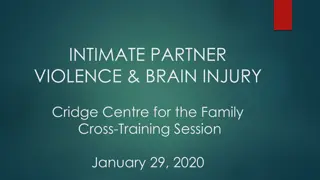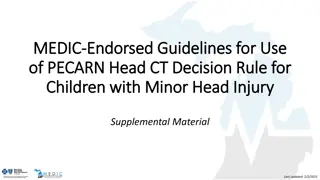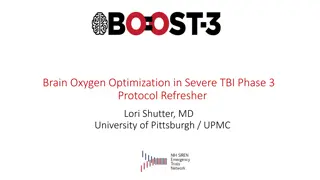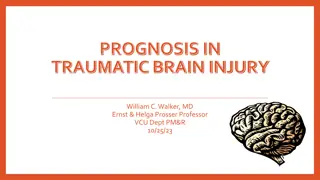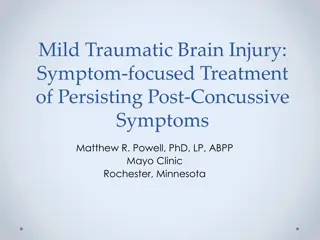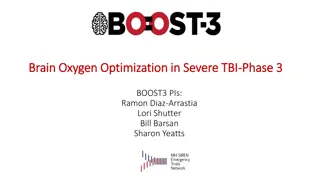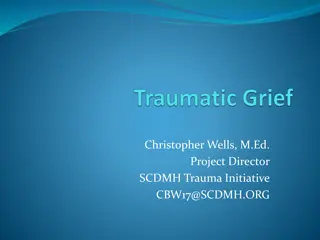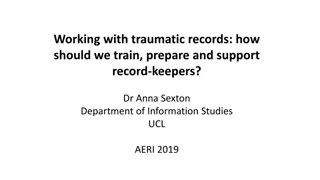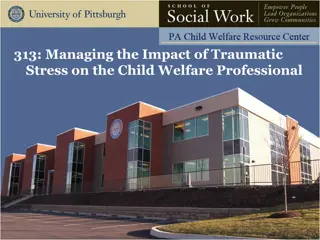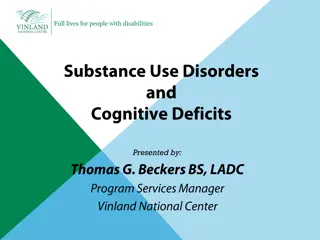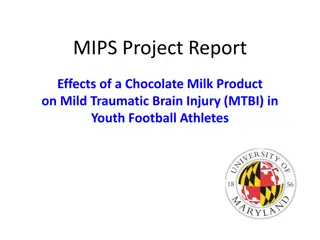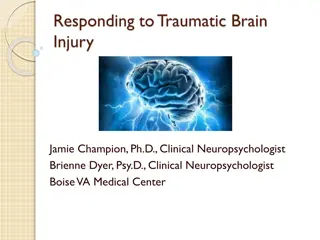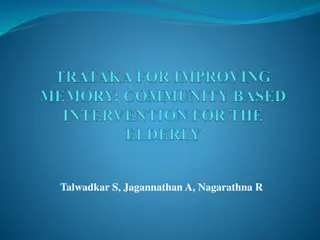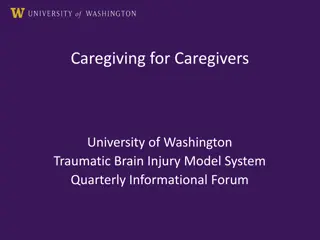Cognitive Deficits and Treatment Options Following Traumatic Brain Injury
Traumatic Brain Injury (TBI) can lead to a range of cognitive deficits and long-term complications, affecting communication, sensory perception, behavior, and more. Severe TBI is associated with EEG frequency shifts and cognitive impairments similar to Alzheimer's disease and schizophrenia. While traditional interventions offer limited help, non-invasive repetitive transcranial magnetic stimulation (rTMS) shows promise in improving cognition post-TBI. Controlled studies are needed to further explore its efficacy.
Download Presentation

Please find below an Image/Link to download the presentation.
The content on the website is provided AS IS for your information and personal use only. It may not be sold, licensed, or shared on other websites without obtaining consent from the author.If you encounter any issues during the download, it is possible that the publisher has removed the file from their server.
You are allowed to download the files provided on this website for personal or commercial use, subject to the condition that they are used lawfully. All files are the property of their respective owners.
The content on the website is provided AS IS for your information and personal use only. It may not be sold, licensed, or shared on other websites without obtaining consent from the author.
E N D
Presentation Transcript
TRAUMATIC BRAIN INJURY SEQUELAE ~25,000 adults with new TBI/year1 ~50,000 with long term complications2 Communication difficulty Sensory deficits Neurobehavioral Emotional problems Personality changes Psychiatric illness Cognitive deficits Most common initial and persistent symptom of TBI Signature injury of middle east wars 2
Severe TBI -> shifts in EEG frequency -> reduced consciousness (Schiff, 2014) Other cognitive deficits (Alzheimer s disease, schizophrenia), also exhibit similar changes in EEG frequency (Babilioni, 2006; Paus, 1999, Gattaz, 1992) Shifts of EEG frequency come from changes in the communication between large groups of cortical neurons Our team previously examined EEG changes after mild TBI in Veterans Found similar pattern of prefrontal EEG slowing (Franke, 2016)
High frequency TMS (>1Hz) depolarizes (activates) neurons under the stimulating coil (Haraldsson, 2004) Prefrontal rTMS stimulation at 10Hz shown to decrease prefrontal and temporal delta activity: We found a significant decrease of delta and theta power on left prefrontal electrodes, mainly localized in the left DLPFC (Wozniak-Kwasniewska, 2014) EEG frequency bands were changed fronto-temporally (right) and were mainly decreases in delta and beta and increases in alpha1-activity (Jandl, 2005) After treatment, the resting electroencephalography revealed a significant decrease in the delta-band activity, which originated in the right prefrontal cortex and correlated with improvements in facial affect recognition. (Kamp, 2016)
No well-supported intervention available to remediate/rebuild cognitive deficits after TBI Compensatory strategies are typically used Pharmaceutical therapies offer only limited potential for improvement (Osier, 2015; Warden, 2006) Non-invasive repetitive transcranial magnetic stimulation (rTMS) has shown some promise in improving cognition in persons with neurologic and psychiatric disorders (Nadeau, 2014; Demirtas-Tatlidede, 2013; Guse 2010) Case reports of cognitive outcomes after rTMS in TBI are encouraging (Dhaliwal, 2015) More controlled studies are necessary
TBI and cognitive deficits are correlated with increased delta activity rTMS has been shown to reduce delta activity in many conditions We hypothesize that rTMS stimulation will induce sustained increases in cortical excitability, thus improving attention and learning 6
Determine efficacy of rTMS on : 1. Objective measures of attention, learning and cognitive control 2. Neurophysiological measures of resting state CNS function 3. Self-reported symptoms 4. Cognitive and functional potential 5. Practical utility and feasibility of using rTMS in a TBI population 7
Magnetic field moving past wire, induces electrical current Current through wire produces magnetic field 8
Wire coiled into figure 8 Focuses magnetic field to tiny area ~ 1 mm2 9
Current from TMS -> magnetic field Magnetic field -> stimulates neuron 11
Ruff 2 and 7 Selective attention test DKEFS Verbal Fluency Test California Verbal Learning test 2 10 minute resting EEG Event related potentials Cortical excitability (i.e. motor threshold) Neurobehavioral symptom inventory (NSI) Mild brain injury atypical symptom scale (MBIAS) Pittsburg Sleep quality index (PSQI) Clinician administered PTSD scale 5 (CAPS-5) Patient health questionnaire (PHQ-9) PROMIS short form pain scale McGill Pain questionnaire short form Traumatic brain injury quality of life (TBI-QOL) General self efficacy scale (GSE) 14
High frequency (10Hz) stimulation of the right DLPFC 20 minutes session (1200 pulses) daily 80% RMT first day, 100% RMT remainder Stimulation parameters chosen at the low end of recommended safety parameters
40 Subjects signed Informed Consent 12 withdrew after consent, but before 1st visit 2 withdrew during study (migraines) 26 Completed Subjects Time commitment was major barrier to recruitment and retention 16
We have observed resting frontal low frequency power increase with mTBI, now replicated in LIMBIC-CENC Hypothesized this is due to hypofunction of arousal and attention networks EEG low frequency links with declining vigilance and reduced consciousness Previous studies of depressed patients have observed improvement in attention and learning with frontal rTMS, left or right Efficacy of rTMS for cognition in TBI is unknown 18
Apply excitatory stimulation to right DLPFC using depression protocol to participants selected for subjective cognitive complaints Cross-over trial Measure attention, learning, memory, and executive function using standardized neuropsychological tests Measure subjective functioning using questionnaires (cognitive complaints, PCS, depression, fatigue, self-efficacy, pain ) Measure brain function using EEG Expect to see: Enhanced arousal, attention and learning Improved symptoms Decrease frontal resting low frequency power in the EEG Enhanced stimulus processing in event-related potentials of EEG 1. 2. 3. 4. 19
Symptoms and performance: 1) Difference scores calculated for each condition 2) T-test of difference scores 3) Time x group ANOVA examines changes over the trial e.g. incidental improvements in cognition EEG power: 1) Band power calculated at relevant EEG sites 2) Time x group ANOVA
No sig effects of stimulation on any measure Practice effects were observed Both controlled and automatic attention became faster and, more accurate Ruff 2 and 7 Automatic Speed T Score Ruff 2 and 7 Automatic Accuracy T Score 50 50 Stim First Sham First
Specific improvement was observed with active stimulation for subjective functioning in several domains Executive Function, Postconcussive symptoms, Sleep, and Depression Postconcussive Symptoms Change Executive Function Change 35 0 30 -5 25 -10 20 -15 15 -20 10 -25 5 -30 0 -35 -5 -40 Active Sham Active Sham 15% improvement About 50% of 4 week inpatient rehab 6% improvement 22
Sleep Quality Change Depression Change 2 0.5 0 -0.5 -2 -1.5 -4 -2.5 -6 -3.5 -8 -4.5 -10 -5.5 Active Sham Active Sham 9% improvement 16% improvement 23
Active TMS did impact slow wave activity Prefrontal delta elevation one week after active stimulation Not same site as stimulation Delta power FP1 Stim First Sham First 24
Executive Function symptom improvement Delta Power Elevation 1 week after stimulation (uV^2) 25
Depression symptom improvement Delta Power Elevation 1 week after stimulation (uV^2) 26
Have not yet examined: 1. Alpha, Beta, Gamma frequencies 2. ERPs may be some stimulus processing effects Brain responses to sound targets appear to be enhanced with active rTMS 3. Resting state measures over task time (vigilance and theta power predicted to sustain longer after TMS) 27
rTMS of DLPFC was not effective for improving learning and attention in mTBI 1. rTMS of DLPFC was effective for depression symptoms, postconcussive symptoms, subjective sleep dysfunction, and subjective executive function in mTBI Safe and well-tolerated; headaches may be contraindication Consistent with known efficacy for depression 2. rTMS to right DLPFC temporarily altered resting delta circuits active over week scale 3. Longer term elevation of prefrontal delta power predicted symptom improvement, therefore is a clue for the mechanism of rTMS s efficacy for executive and depression symptoms 4. 28
Statistically significant improvements in PCS, sleep, depression, and executive function While there was no improvement in objective cognition, subjective functioning may be even more important: Neurobehavioral and psychological symptoms elevated in mTBI but neuropsychological function is typically normal Midlife signals of poor outcomes in aging Most prominent physiologic brain signal in chronic mTBI is strongly associated with depression and anxiety symptoms rTMS may benefit mTBI with subjective cognitive deficits, especially for those with PCS, depression, and/or sleep disorders rTMS may create a window of plasticity, priming for other rehab programs 29
Not clinically depressed: Neuropsychological benefits in medically refractory depression1, and TBI groups selected for depression2 Our results similar to very recent study in severe TBI (no neuropsychological benefit)3 TBI depressive symptoms less severe, less problematic for cognition than refractory clinical depression Possibility of other neuropsych process impacted, harder to measure e.g. meta- cognition RDLPFC associated with accuracy of self-assessment 30
Long-term but not permanent changes in large scale cortical communication Delta modulates local activity over large regions Long-term but impermanent plasticity of networks: EEG correlate of long-term network Hebbian learning? Delta power rebound in motor cortex-connected regions after movement activity Temporary Changes in Internalizing : Inward mentation, loss of response to external world Positive mood and serotonergic manipulations 31
How might one affect objective cognitive functioning? DLPFC for symptoms followed by cognitive training Outcomes: self-awareness; monitoring 32
Manuscript underway Analyze stimulus processing and vigilance measures 33
Intervention staff Sheryl Underwood Padraic Flynn Advisory Leadership David Cifu William Walker Kathryn Holloway Ravi Hadimani Biostatistician Robert Perera VA institutional advisor Tiffany Lewis Special thank you to George Gitchel McGuire Research Institute McGuire Research Institute





